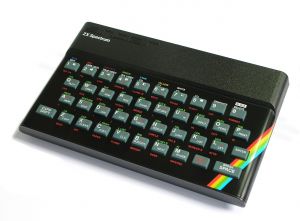Difference between revisions of "Configuration:ZxSpectrum"
| Line 1: | Line 1: | ||
| + | {{Infobox System|Logo=logo-sinclair.jpg|Image=device-zx-spectrum.jpg|Year=1982|Manufacturer=Sinclair Research<br>Timex Corporation|Type=Personal Computer|CPU=Z80 @ 3.5 MHz|GPU=TBA|Sound CPU=TBA|Sound Chip=TBA|Memory=16 KB / 48 KB / 128 KB|Controllers=Keyboard<br>Joystick}} | ||
| + | |||
== Platform Information == | == Platform Information == | ||
| + | ''from Wikipedia'' | ||
| + | |||
| + | The ZX Spectrum (UK: /zɛd ɛks ˈspɛktrəm/) is an 8-bit personal home computer released in the United Kingdom in 1982 by Sinclair Research. It was manufactured in Dundee, Scotland, in the now closed Timex factory. | ||
| + | |||
| + | Referred to during development as the ZX81 Colour and ZX82, it was launched as the ZX Spectrum by Sinclair to highlight the machine's colour display, compared with the black and white of its predecessor, the ZX81. The Spectrum was released as eight different models, ranging from the entry level with 16 KB RAM released in 1982 to the ZX Spectrum +3 with 128 KB RAM and built in floppy disk drive in 1987; together they sold over 5 million units worldwide (not counting clones). | ||
| + | |||
| + | The Spectrum was among the first mainstream-audience home computers in the UK, similar in significance to the Commodore 64 in the USA. The introduction of the ZX Spectrum led to a boom in companies producing software and hardware for the machine, the effects of which are still seen; some credit it as the machine which launched the UK IT industry. Licensing deals and clones followed, and earned Clive Sinclair a knighthood for "services to British industry". | ||
| + | |||
| + | The Commodore 64, Dragon 32, Oric-1 and Atmos, BBC Micro and later the Amstrad CPC range were rivals to the Spectrum in the UK market during the early 1980s. Over 24,000 software titles have been released since the Spectrum's launch and new titles continue to be released—over 100 in 2012. In 2014, a Bluetooth keyboard modelled on the Spectrum was announced. | ||
=== Media Devices === | === Media Devices === | ||
| Line 9: | Line 20: | ||
* [[Emulator:FBZX|FBZX]] | * [[Emulator:FBZX|FBZX]] | ||
* [[Emulator:Speccy|Speccy]] | * [[Emulator:Speccy|Speccy]] | ||
| + | |||
| + | == External Links == | ||
| + | * [https://en.wikipedia.org/wiki/ZX_Spectrum Wikipedia] | ||
[[Category:Platform]] | [[Category:Platform]] | ||
Latest revision as of 13:49, 14 October 2017
| Configuration:ZxSpectrum | ||
|---|---|---|

| ||

| ||
| Manufacturer | Sinclair Research Timex Corporation | |
| Type | Personal Computer | |
| CPU | Z80 @ 3.5 MHz | |
| GPU | TBA | |
| Sound CPU | TBA | |
| Sound Chip | TBA | |
| Memory | 16 KB / 48 KB / 128 KB | |
| Controllers | Keyboard Joystick | |
| Year | 1982 | |
Platform Information
from Wikipedia
The ZX Spectrum (UK: /zɛd ɛks ˈspɛktrəm/) is an 8-bit personal home computer released in the United Kingdom in 1982 by Sinclair Research. It was manufactured in Dundee, Scotland, in the now closed Timex factory.
Referred to during development as the ZX81 Colour and ZX82, it was launched as the ZX Spectrum by Sinclair to highlight the machine's colour display, compared with the black and white of its predecessor, the ZX81. The Spectrum was released as eight different models, ranging from the entry level with 16 KB RAM released in 1982 to the ZX Spectrum +3 with 128 KB RAM and built in floppy disk drive in 1987; together they sold over 5 million units worldwide (not counting clones).
The Spectrum was among the first mainstream-audience home computers in the UK, similar in significance to the Commodore 64 in the USA. The introduction of the ZX Spectrum led to a boom in companies producing software and hardware for the machine, the effects of which are still seen; some credit it as the machine which launched the UK IT industry. Licensing deals and clones followed, and earned Clive Sinclair a knighthood for "services to British industry".
The Commodore 64, Dragon 32, Oric-1 and Atmos, BBC Micro and later the Amstrad CPC range were rivals to the Spectrum in the UK market during the early 1980s. Over 24,000 software titles have been released since the Spectrum's launch and new titles continue to be released—over 100 in 2012. In 2014, a Bluetooth keyboard modelled on the Spectrum was announced.
Media Devices
- ROM Images
Available Emulators
Below is a list of available emulators for this platform.